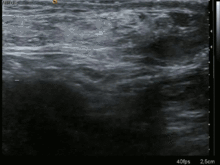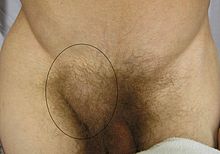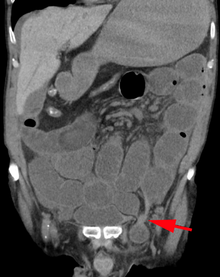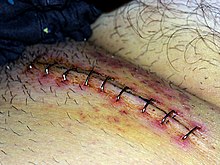Inguinal hernia: Difference between revisions
Undid revision 649066500 by 41.190.137.78 (talk) rvv |
updated |
||
| Line 17: | Line 17: | ||
MeshNumber = C06.405.293.249.437 | |
MeshNumber = C06.405.293.249.437 | |
||
}} |
}} |
||
<!-- Definition and symptoms --> |
|||
An '''inguinal hernia''' {{IPAc-en|ˈ|ɪ|ŋ|ɡ|w|ɨ|n|əl|_|ˈ|h|ɜr|n|i|ə}} is a protrusion of [[abdominal cavity|abdominal-cavity]] contents through the [[inguinal canal]]. Symptoms are present in about 66% of people.<!-- <ref name=NEJM15/> --> This may include pain or discomfort especially with coughing, exercise, or going to the toilet.<!-- <ref name=NEJM15/> --> Often it gets worse throughout the day and improves when lying down.<!-- <ref name=NEJM15/> --> A bulging area may occur that becomes larger when bearing down.<!-- <ref name=NEJM15/> --> Ingional hernias occur more often on the right than left side.<!-- <ref name=NEJM15/> --> The main concern is [[strangulating|strangulation]], were the blood supply to part of the bowel is blocked.<!-- <ref name=NEJM15/> --> This usually produces severe pain and tenderness of the area.<ref name=NEJM15/> |
|||
<!-- Cause and diagnosis--> |
|||
An '''inguinal hernia''' {{IPAc-en|ˈ|ɪ|ŋ|ɡ|w|ɨ|n|əl|_|ˈ|h|ɜr|n|i|ə}} is a protrusion of [[abdominal cavity|abdominal-cavity]] contents through the [[inguinal canal]]. They are very common in men (lifetime risk 27% for men, 3% for women<ref>{{cite journal |author= John T Jenkins, Patrick J O’Dwyer |title= Inguinal hernias|journal= BMJ |volume=336 |pages=269–272 |year=2008 |doi= 10.1136/bmj.39450.428275.AD |pmc= 2223000 |pmid= 18244999 |issue= 7638|last2= O'Dwyer}}</ref>). Though their [[Inguinal hernia repair|repair]] is one of the most frequently performed [[surgery|surgical]] operations, [[elective surgery]] is no longer recommended in minimally symptomatic cases, due to the low risk of [[Incarcerated hernia#Complications|incarceration]] (<0.2% per year) and the significant risk (10–12%) of [[inguinodynia|post herniorraphy pain syndrome]].<ref name=Fitzgibbons06>{{cite journal |author=Fitzgibbons RJ, Giobbie-Hurder A, Gibbs JO |title=Watchful waiting vs repair of inguinal hernia in minimally symptomatic men: a randomized clinical trial |journal=JAMA |volume=295 |issue=3 |pages=285–92 |date=January 2006 |pmid=16418463 |doi=10.1001/jama.295.3.285 |url=http://jama.ama-assn.org/content/295/3/285.full|author2=and others |displayauthors=1 }}</ref><ref>{{cite journal |author=Simons MP, Aufenacker T, Bay-Nielsen M |title=European Hernia Society guidelines on the treatment of inguinal hernia in adult patients |journal=Hernia |volume=13 |issue=4 |pages=343–403 |date=August 2009 |pmid=19636493 |pmc=2719730 |doi=10.1007/s10029-009-0529-7 |author2=and others |displayauthors=1 }}</ref> |
|||
Risk factors for the development of a hernia include: smoking, [[chronic obstructive pulmonary disease]], [[obesity]], [[pregnancy]], [[peritoneal dialysis]], [[collagen vascular disease]], and previous open [[appendectomy]], among others.<ref name=NEJM15/><ref name=Dom2014>{{cite book|last1=Domino|first1=Frank J.|title=The 5-minute clinical consult 2014|date=2014|publisher=Wolters Kluwer Health/Lippincott Williams & Wilkins|location=Philadelphia, Pa.|isbn=9781451188509|page=562|edition=22nd ed.|url=https://books.google.ca/books?id=2C2MAwAAQBAJ&pg=PA562}}</ref> Hernias are partly genetic and occur more often in certain families.<!-- <ref name=NEJM15/> --> It is unclear if inguinal hernias are associated with heavy lifting.<!-- <ref name=NEJM15/> --> Hernias can often be diagnosed based on signs and symptoms.<!-- <ref name=NEJM15/> --> Occasionally [[medical imaging]] is used to confirm the diagnosis or rule out other possible causes.<ref name=NEJM15/> |
|||
<!-- Treatment --> |
|||
Groin hernias that do not cause symptoms in males do not need to be repaired.<!-- <ref name=NEJM15/> --> Repair; however, is generally recommended in women due to the higher rate of [[femoral hernia]]s which have more complications.<!-- <ref name=NEJM15/> --> If strangulation occurs [[surgical emergency|immediate surgery]] is required.<!-- <ref name=NEJM15/> --> Repair may be done by open surgery of by [[laparoscopic surgery]].<!-- <ref name=NEJM15/> --> Open surgery has the benefit of possibly being done under [[local anesthesia]] rather than [[general anesthesia]].<!-- <ref name=NEJM15/> --> Laparoscopic surgery generally has less pain following the procedure.<ref name=NEJM15/><ref>{{cite journal |author=Simons MP, Aufenacker T, Bay-Nielsen M |title=European Hernia Society guidelines on the treatment of inguinal hernia in adult patients |journal=Hernia |volume=13 |issue=4 |pages=343–403 |date=August 2009 |pmid=19636493 |pmc=2719730 |doi=10.1007/s10029-009-0529-7 |author2=and others |displayauthors=1 }}</ref> |
|||
<!-- Epidemiology --> |
|||
About 27% of males and 3% of females develop a groin hernia at some time in their life.<ref name=NEJM15>{{cite journal|last1=Fitzgibbons RJ|first1=Jr|last2=Forse|first2=RA|title=Clinical practice. Groin hernias in adults.|journal=The New England journal of medicine|date=19 February 2015|volume=372|issue=8|pages=756-63|pmid=25693015}}</ref> Groin hernias occur most often before the age of one and after the age of fifty.<ref name=Dom2014/> Inguinal, femoral and abdominal hernias resulted in 51,000 deaths in 2013 and 55,000 in 1990.<ref name=GDB2013>{{cite journal|last1=GBD 2013 Mortality and Causes of Death|first1=Collaborators|title=Global, regional, and national age-sex specific all-cause and cause-specific mortality for 240 causes of death, 1990-2013: a systematic analysis for the Global Burden of Disease Study 2013.|journal=Lancet|date=17 December 2014|pmid=25530442|doi=10.1016/S0140-6736(14)61682-2}}</ref> |
|||
== Classification == |
== Classification == |
||
Revision as of 06:03, 12 March 2015
It has been suggested that Indirect inguinal hernia be merged into this article. (Discuss) Proposed since August 2013. |
It has been suggested that Direct inguinal hernia be merged into this article. (Discuss) Proposed since August 2013. |
| Inguinal hernia | |
|---|---|
| Specialty | Gastroenterology |
An inguinal hernia /ˈɪŋɡw[invalid input: 'ɨ']nəl ˈhɜːrniə/ is a protrusion of abdominal-cavity contents through the inguinal canal. Symptoms are present in about 66% of people. This may include pain or discomfort especially with coughing, exercise, or going to the toilet. Often it gets worse throughout the day and improves when lying down. A bulging area may occur that becomes larger when bearing down. Ingional hernias occur more often on the right than left side. The main concern is strangulation, were the blood supply to part of the bowel is blocked. This usually produces severe pain and tenderness of the area.[1]
Risk factors for the development of a hernia include: smoking, chronic obstructive pulmonary disease, obesity, pregnancy, peritoneal dialysis, collagen vascular disease, and previous open appendectomy, among others.[1][2] Hernias are partly genetic and occur more often in certain families. It is unclear if inguinal hernias are associated with heavy lifting. Hernias can often be diagnosed based on signs and symptoms. Occasionally medical imaging is used to confirm the diagnosis or rule out other possible causes.[1]
Groin hernias that do not cause symptoms in males do not need to be repaired. Repair; however, is generally recommended in women due to the higher rate of femoral hernias which have more complications. If strangulation occurs immediate surgery is required. Repair may be done by open surgery of by laparoscopic surgery. Open surgery has the benefit of possibly being done under local anesthesia rather than general anesthesia. Laparoscopic surgery generally has less pain following the procedure.[1][3]
About 27% of males and 3% of females develop a groin hernia at some time in their life.[1] Groin hernias occur most often before the age of one and after the age of fifty.[2] Inguinal, femoral and abdominal hernias resulted in 51,000 deaths in 2013 and 55,000 in 1990.[4]
Classification
There are two types of inguinal hernia, direct and indirect, which are defined by their relationship to the inferior epigastric vessels. Direct inguinal hernias occur medial to the inferior epigastric vessels when abdominal contents herniate through a weak spot in the fascia of the posterior wall of the inguinal canal, which is formed by the transversalis fascia. Indirect inguinal hernias occur when abdominal contents protrude through the deep inguinal ring, lateral to the inferior epigastric vessels; this may be caused by failure of embryonic closure of the processus vaginalis.
In the case of the female, the opening of the superficial inguinal ring is smaller than that of the male. As a result, the possibility for hernias through the inguinal canal in males is much greater because they have a larger opening and therefore a much weaker wall through which the intestines may protrude.
| Type | Description | Relationship to inferior epigastric vessels | Covered by internal spermatic fascia? | Usual onset |
|---|---|---|---|---|
| indirect inguinal hernia | protrudes through the inguinal ring and is ultimately the result of the failure of embryonic closure of the internal inguinal ring after the testicle passes through it | Lateral | Yes | Congenital / Adult |
| direct inguinal hernia | enters through a weak point in the fascia of the abdominal wall (Hesselbach triangle) | Medial | No | Adult |
Inguinal hernias, in turn, belong to groin hernias, which also includes femoral hernias. A femoral hernia is not via the inguinal canal, but via the femoral canal, which normally allows passage of the common femoral artery and vein from the pelvis to the leg.
In Amyand's hernia, the content of the hernial sac is the vermiform appendix.

In Littre's hernia, the content of the hernial sac contains a Meckel's Diverticulum.
Clinical classification of hernia is also important according to which hernia is classified into
- Reducible hernia: is one which can be pushed back into the abdomen by putting manual pressure to it.
- Irreducible/Incarcerated hernia: is one which cannot be pushed back into the abdomen by applying manual pressure.
Irreducible hernias are further classified into
- Obstructed hernia: is one in which the lumen of the herniated part of intestine is obstructed.
- Strangulated hernia: is one in which the blood supply of the hernia contents is cut off, thus, leading to ischemia. The lumen of the intestine may be patent or not.
Signs and symptoms



Hernias present as bulges in the groin area that can become more prominent when coughing, straining, or standing up. They are rarely painful, and the bulge commonly disappears on lying down. The inability to "reduce", or place the bulge back into the abdomen usually means the hernia is 'incarcerated' which requires emergency surgery.
Significant pain is suggestive of strangulated bowel (an incarcerated indirect inguinal hernia).
As the hernia progresses, contents of the abdominal cavity, such as the intestines, liver, can descend into the hernia and run the risk of being pinched within the hernia, causing an intestinal obstruction. If the blood supply of the portion of the intestine caught in the hernia is compromised, the hernia is deemed "strangulated" and gut ischemia and gangrene can result, with potentially fatal consequences. The timing of complications is not predictable. Emergency surgery for incarceration and strangulation carry much higher risk than planned, "elective" procedures. However, the risk of incarceration is low, evaluated at 0.2% per year.[5] On the other hand, surgical intervention has a significant risk of causing inguinodynia, and this is why minimally symptomatic patients are advised to watchful waiting.
Differential Diagnosis
Differential diagnosis of the symptoms of inguinal hernia mainly includes the following potential conditions:[6]
- Femoral hernia
- Epididymitis
- Testicular torsion
- Lipomas
- Inguinal adenopathy (Lymph node Swelling)
- Groin abscess
- Saphenous vein dilation, called Saphena varix
- Vascular aneurysm or pseudoaneurysm
- Hydrocele
- Varicocele
- Cryptorchidism (Undescended testes)
Pathophysiology
In men, indirect hernias follow the same route as the descending testes, which migrate from the abdomen into the scrotum during the development of the urinary and reproductive organs. The larger size of their inguinal canal, which transmitted the testicle and accommodates the structures of the spermatic cord, might be one reason why men are 25 times more likely to have an inguinal hernia than women. Although several mechanisms such as strength of the posterior wall of the inguinal canal and shutter mechanisms compensating for raised intra-abdominal pressure prevent hernia formation in normal individuals, the exact importance of each factor is still under debate. The physiological school of thought thinks that the risk of hernia is due to a physiological difference between patients who suffer hernia and those who do not, namely the presence of aponeurotic extensions from the transversus abdominis aponeurotic arch.[7]
Management
Conservative
There is currently no medical recommendation about how to manage an inguinal hernia condition, due to the fact that until recently,[8][9] elective surgery used to be recommended. The hernia truss is intended to contain a reducible inguinal hernia within the abdomen. It is not considered to provide a cure, and if the pads are hard and intrude into the hernia aperture they may cause scarring and enlargement of the aperture. In addition, most trusses with older designs are not able effectively to contain the hernia at all times, because their pads do not remain permanently in contact with the hernia. The more modern variety of truss is made with non-intrusive flat pads and comes with a guarantee to hold the hernia securely during all activities. Although there is as yet no proof that such devices can prevent an inguinal hernia from progressing, they have been described by users as providing greater confidence and comfort when carrying out physically demanding tasks.[citation needed] A truss also increases the probability of complications,which include strangulation of the hernia, atrophy of the spermatic cord, and atrophy of the fascial margins.This allows the defect to enlarge and makes subsequent repair more difficult.[10] Their popularity is likely to increase, as many individuals with small, painless hernias are now delaying hernia surgery due to the risk of post-herniorrhaphy pain syndrome.[11] The elasticised pants used by athletes also provide useful support for the smaller hernia.
Surgical

Surgical correction of inguinal hernias is called a hernia repair. It is currently not recommended in minimally symptomatic hernias, for which watchful waiting is advised, due to the risk of post herniorraphy pain syndrome. Surgery is commonly performed as outpatient surgery. There are various surgical strategies which may be considered in the planning of inguinal hernia repair. These include the consideration of mesh use (e.g. synthetic or biologic), open repair, use of laparoscopy, type of anesthesia (general or local), appropriateness of bilateral repair, etc. Laparascopy is most commonly used for non-emergent cases, however, a minimally invasive open repair may have a lower incidence of post-operative nausea and mesh associated pain.[12] During surgery conducted under local anaesthesia, the patient will be asked to cough and strain during the procedure to help in demonstrating that the repair is without tension and sound.[13] Constipation after hernia repair results in strain to evacuate the bowel causing pain, and fear that the sutures may rupture. Opioid analgesia makes constipation worse. Promoting an easy bowel motion is important post-operatively.
Epidemiology
A direct inguinal hernia is less common (~25–30% of inguinal hernias) and usually occurs in men over 40 years of age.
Gallery
-
Illustration of an inguinal hernia.
-
Different types of inguinal hernias.
-
Inguinal fossae
-
Old & new hernia scars 2009
-
Bilateral Hernia scars 7 days after surgery
See also
 Media related to Inguinal hernia at Wikimedia Commons
Media related to Inguinal hernia at Wikimedia Commons- Birkett hernia
References
- ^ a b c d e Fitzgibbons RJ, Jr; Forse, RA (19 February 2015). "Clinical practice. Groin hernias in adults". The New England journal of medicine. 372 (8): 756–63. PMID 25693015.
- ^ a b Domino, Frank J. (2014). The 5-minute clinical consult 2014 (22nd ed. ed.). Philadelphia, Pa.: Wolters Kluwer Health/Lippincott Williams & Wilkins. p. 562. ISBN 9781451188509.
{{cite book}}:|edition=has extra text (help) - ^ Simons MP, Aufenacker T, Bay-Nielsen M; et al. (August 2009). "European Hernia Society guidelines on the treatment of inguinal hernia in adult patients". Hernia. 13 (4): 343–403. doi:10.1007/s10029-009-0529-7. PMC 2719730. PMID 19636493.
{{cite journal}}: Explicit use of et al. in:|author2=(help); Unknown parameter|displayauthors=ignored (|display-authors=suggested) (help)CS1 maint: multiple names: authors list (link) - ^ GBD 2013 Mortality and Causes of Death, Collaborators (17 December 2014). "Global, regional, and national age-sex specific all-cause and cause-specific mortality for 240 causes of death, 1990-2013: a systematic analysis for the Global Burden of Disease Study 2013". Lancet. doi:10.1016/S0140-6736(14)61682-2. PMID 25530442.
{{cite journal}}:|first1=has generic name (help)CS1 maint: numeric names: authors list (link) - ^ Cite error: The named reference
Fitzgibbons06was invoked but never defined (see the help page). - ^ Trudie A Goers; Washington University School of Medicine Department of Surgery; Klingensmith, Mary E; Li Ern Chen; Sean C Glasgow (2008). The Washington manual of surgery. Philadelphia: Wolters Kluwer Health/Lippincott Williams & Wilkins. ISBN 0-7817-7447-0.
{{cite book}}: CS1 maint: multiple names: authors list (link) - ^ Desarda MP (2003). "Surgical physiology of inguinal hernia repair—a study of 200 cases". BMC Surg. 3: 2. doi:10.1186/1471-2482-3-2. PMC 155644. PMID 12697071.
{{cite journal}}: CS1 maint: unflagged free DOI (link) - ^ Simons, M. P.; Aufenacker, T.; Bay-Nielsen, M.; Bouillot, J. L.; Campanelli, G.; Conze, J.; Lange, D.; Fortelny, R.; et al. (2009). "European Hernia Society guidelines on the treatment of inguinal hernia in adult patients". Hernia. 13 (4): 343–403. doi:10.1007/s10029-009-0529-7. PMC 2719730. PMID 19636493.
- ^ Rosenberg, J; Bisgaard, T; Kehlet, H; Wara, P; Asmussen, T; Juul, P; Strand, L; Andersen, FH; et al. (2011). "Danish Hernia Database recommendations for the management of inguinal and femoral hernia in adults". Danish medical bulletin. 58 (2): C4243. PMID 21299930.
- ^ Purkayastha S, Chow A, Athanasiou T, Tekkis P, Darzi A; Chow; Athanasiou; Tekkis; Darzi (2008). "Inguinal hernia". Clin Evid (Online). 2008. PMC 2908002. PMID 19445744.
{{cite journal}}: CS1 maint: multiple names: authors list (link) - ^ Aasvang E, Kehlet H; Kehlet (July 2005). "Chronic postoperative pain: the case of inguinal herniorrhaphy". Br J Anaesth. 95 (1): 69–76. doi:10.1093/bja/aei019. PMID 15531621.
- ^ Reinhorn, Michael. "Minimally Invasive Open Inguinal Hernia Repair". www.jomi.com. Journal of Medical Insight. Retrieved 29 August 2014.
- ^ Inguinal Hernia





